you are here: mainpage > hardware
this page will be continuously updated
last update:
12-jul-04
We all know a PC, probably heard of supercomputers. But mainframes are not so known.
When you watch television and see a movie with a big machine, or hear people talking to each other (at college) about a mainframe do you sometimes wonder what that is? What they are talking about? Then this page is intended for you.
This page is the first in a future series to explain what a mainframe is and how it evolved in history. Who were the pioneers and what companies were, and still are, involved.
How did and how do they look like? On this page are a few pictures of the earliest mainframes.
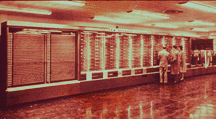
When you think of a mainframe do you think of a large computer? Right!
But how large is it and what does it do, and what is its place in the family of computers we know
| Quantum computers | |
| Grid computers | |
| Supercomputers | |
| Mainframes | |
| Mini computers | |
| Microcomputers | |
| Terminals | |
| Embedded computers |
The ranking of a mainframe is as you can see almost at the top.
A mainframe is simply a very large computer. And totally different from what you have on your desk. Don't say: what seems to be a mainframe today is on your desktop tomorrow. Apart from the CPU's (processors) that is far from true.
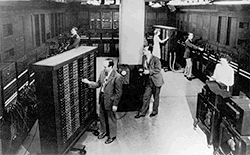
Mainframe is an industry term for a large computer. The name comes from the way the machine is build up: all units (processing, communication etc.) were hung into a frame. Thus the maincomputer is build into a frame, therefore: Mainframe
And because of the sheer development costs, mainframes are typically manufactured by a large company such as IBM, Amdahl, Hitachi.
Their main purpose is to run commercial applications of Fortune 1000 businesses
and other large-scale computing purposes.
Think here of banking and insurance businesses where enormous amounts of data
are processed, typically (at least) millions of records, each day.
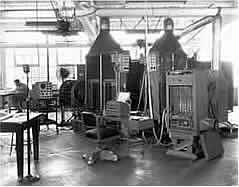
But what classifies a computer as a mainframe?
Historically, a mainframe is associated with centralized computing opposite from distributed computing. Meaning all computing takes (physically) place on the mainframe itself: the processor section.
Building mainframes started with the MarkI soon to be followed by tens of other types and manufacturers. But as said earlier, because of the development costs only governments and large firms could pay for the development of such behemoths.
Have a look at some early mainframes:
| Mainframe | Year |
| ENIAC | 1942 |
| MarkI | 1944 |
| BINAC | 1949 |
| Whirlwind | 1960 |
| UNIVAC | 1952 |
| IBM 701 | 1953 |
| IBM 360 | 1963 |
![]() Atanasoff-Berry
Computer created at Iowa State
Atanasoff-Berry
Computer created at Iowa State
![]() Konrad
Zuse -Z2 uses telephone relays instead of mechanical logical circuits
Konrad
Zuse -Z2 uses telephone relays instead of mechanical logical circuits
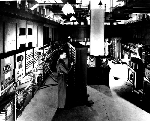
![]() Colossus
- British vacuum tube computer
Colossus
- British vacuum tube computer
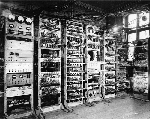
Manchester Mark1
![]() J. Presper
Eckert & John Mauchly, ACM, AEEI, ENIAC
J. Presper
Eckert & John Mauchly, ACM, AEEI, ENIAC
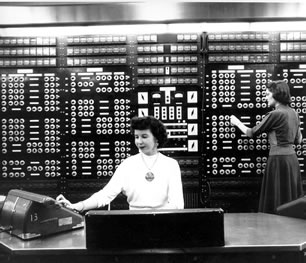
![]() Harvard Mark
II (Magnetic Drum Storage)
Harvard Mark
II (Magnetic Drum Storage)
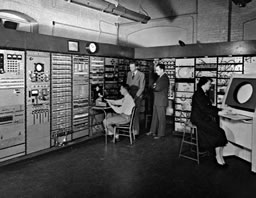
whirlwind
![]() Whirlwind at
MIT
Whirlwind at
MIT
![]() Manchester
Mark I (1st stored-program digital computer),
Manchester
Mark I (1st stored-program digital computer),

Univac I
![]() Univac I first
deliverey to the US Census Bureau
Univac I first
deliverey to the US Census Bureau
![]() Illiac I, Univac
I at Livermore predicts 1952 election, MANIAC built at Los Alamos, AVIDAC built
at Argonne
Illiac I, Univac
I at Livermore predicts 1952 election, MANIAC built at Los Alamos, AVIDAC built
at Argonne
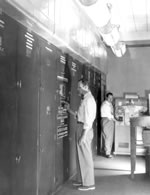
Edvac
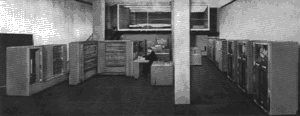
IBM 701
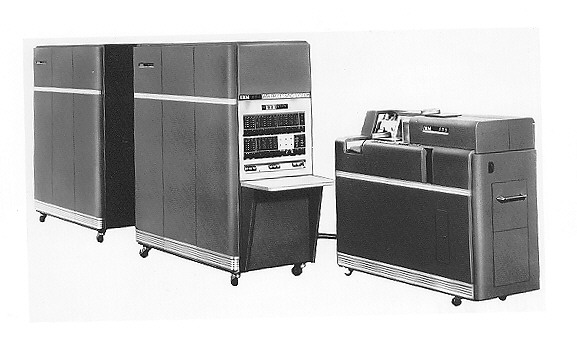
![]() IBM 650 (first
mass-produced computer),
IBM 650 (first
mass-produced computer),
![]() FORTRAN developed
by John Backus
FORTRAN developed
by John Backus
![]() ORACLE-Oak
Ridge Automated Computer And Logical Engine
ORACLE-Oak
Ridge Automated Computer And Logical Engine
![]() Texas Instruments
introduces the silicon transistor,
Texas Instruments
introduces the silicon transistor,
![]() Univac II introduced
Univac II introduced
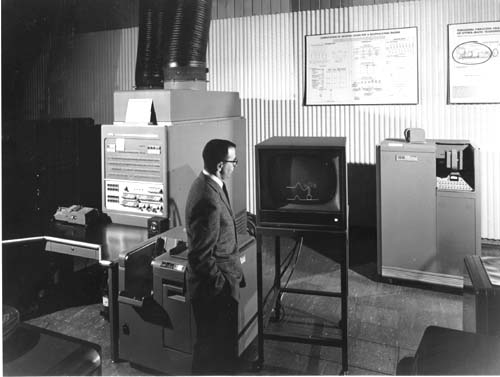 IBM 704
IBM 704
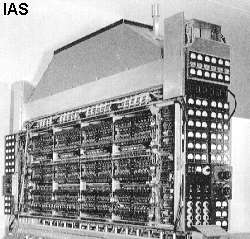
![]() MANIAC 2,
DEUCE (fixed head drum memory), clone of IAS
MANIAC 2,
DEUCE (fixed head drum memory), clone of IAS
![]() Nippon Telegraph
& Telephone Musasino-1: 1st parametron computer, Jack Kilby-First integrated
circuit prototype; Robert Noyce works separately on IC's, NEC 1101 & 1102
Nippon Telegraph
& Telephone Musasino-1: 1st parametron computer, Jack Kilby-First integrated
circuit prototype; Robert Noyce works separately on IC's, NEC 1101 & 1102
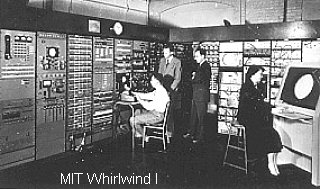
![]() Paul Baran
at Rand develops packet-switching, NEAC 2201,
Paul Baran
at Rand develops packet-switching, NEAC 2201,
![]() Whirlwind-air
traffic control,
Whirlwind-air
traffic control,
![]() Livermore Advanced
Research Computer (LARC),
Livermore Advanced
Research Computer (LARC),
![]() Control Data
Corporation CDC 1604,
Control Data
Corporation CDC 1604,
![]() First major
international computer conference
First major
international computer conference
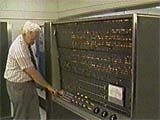
Stretch
![]() IBM Stretch-Multiprogramming
IBM Stretch-Multiprogramming

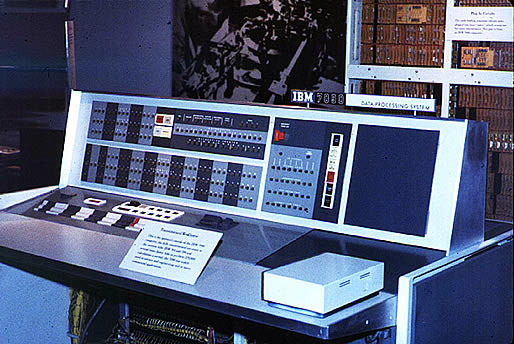
![]() First use of
virtual memory in a mainframe computer.(4)
First use of
virtual memory in a mainframe computer.(4)
![]() Control Data
Corporation opens lab in Chippewa Falls headed by Seymour Cray,
Control Data
Corporation opens lab in Chippewa Falls headed by Seymour Cray,
![]() Telestar launched,
Telestar launched,
![]() Atlas-virtual
memory and pipelined operations,
Atlas-virtual
memory and pipelined operations,
![]() Timesharing-IBM
709 and 7090
Timesharing-IBM
709 and 7090
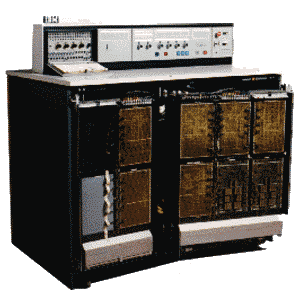
IBM 360
![]() IBM 360-third
generation computer family.
IBM 360-third
generation computer family.
![]() The Sage System,
The Sage System,
From the late 1990's mainframe manufacturers started to leave the mainframe
market, thinking mainframe business to be less profitable. And then there was
virtually only one of major importance left: IBM. And as the single (most important)
manufacturer IBM could dictate its own prices and sales went up as well as profits.
Not surprisingly IBM's innovations in new mainframe architecture left the rest
far behind.
In due time this was observed by other computer manufacturers and since 2001
competition got stronger again.
In the early days output came via a paper tape.
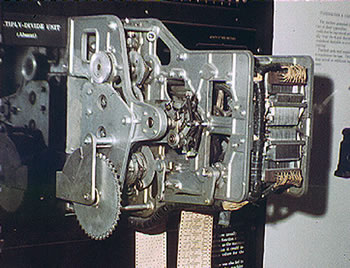
Later by an array of burning lamps and when the vacuumtube technology became sophisticated enough to build a CRT output came by means of spots on the screen (see williams tube).
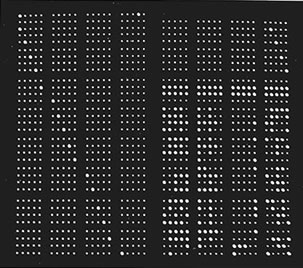
At first there was no operating system. Most machines were hard wired. Programming
it meant rewiring panels and setting hundreds of switches to have the machine
calculate a table.
The next years when programming languages became available and memory was no
longer a problem programmers created operating systems. You no longer had to
be an electrical engineer to program a machine like that.
That made it possible for scientists and other users to quickly make a program and get the results.
To take care of all this a mainframe needs a sophisticated Operating System.
And as you look at it closely also quite different from what you find on your
desktops machine. Almost always text based terminals (no graphics) are connected
to it. Also PC's can be connected to a mainframe with a special interface program
- often called 3270 emulation.
But a mainframe does have some particular properties:
Operating systems for mainframes are few in number: UNIX, Linux, VMS, Z/OS, Z/VM, VSE/ESA. The latter three are of IBM origin and all three: VMS, Linux and Unix also run on IBM mainframes(2)
However there are some dialects of VMS, Linux, and Unix running on different machines.
When the first programming languages like Cobol, Fortran and Algol were created every large company and institution could hire people to do the programming of administration or complicated scientific calculations. The atomic bomb project in Los Alamos was a prime example of doing calculations using computers, without it the project never had succeeded in time.
Many scientists have contributed to the mainframe computer as it is now. Things did not go as smooth and fast as it goes nowadays. Sometimes many items, mechanisms, or materials still had to be invented before things really got on their way. On line memory was a crucial phase in developing large computers. Also when timesharing was invented in the late 60's mainframe use exploded.
To create a mainframe one needed at least a few hundred thousand dollars to
build the first types.
Later types of the 60' and 70's required a few million dollars and now depending
on what capacities you need mainframes range between two three hundred to several
tens of millions
It is reasonable to say that small companies can not afford to spent that kind
of money to develop one machine or prototype.
Thus firms like:
Ahmdal (Hitachi)
Bull
Comparex (Hitachi)
DEC (Compaq)
Fujitsu
Hitatchi
IBM
ICL (Hitachi)
NEC
Siemens
Unisys
Sun
and the like were the only ones financially capable of developing mainframe machines.
As mainframe markets shrunk some companies were assimilated by their peers and other congregated into even larger firms.
Conclusion
A (modern) mainframe is still a very large machine, sometimes tens of square
meters. Has usually more than one processor and loads of memory: often running
between a few mega- to several hundreds Gb of RAM.
It has tons of disk space and other storage facilities in large size and quantities
that are not normally found with mini or micro computers. And although it looks
like hundreds of users are using the machine simultaneously it is all governed
by a sophisticated time sharing system, hence: serialization. (per processor)
 IBM
701 (1952)
IBM
701 (1952)
Introduction | Chronology | Construction | Operatingsystems | Programming | Pioneers | Companies
![]()
| Last Updated on July 12, 2004 | For suggestions please mail the editors |
Footnotes & References
| 1 | part of this text is based on the page: icarus.brainerd.net/~kuck/history/mainfram.html. by AJ Morgan |
| 2 | Leslie Willoughby supplied the extra OS info on IBM mainframes |
| 3 | picture graphically reworked from computer encyclopedia: Mark Greenia |
| 4 | Marian Bozdoc, Auckland NZ, |